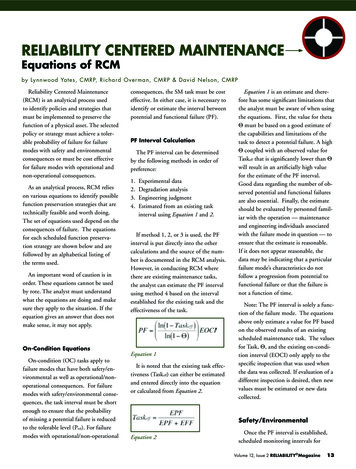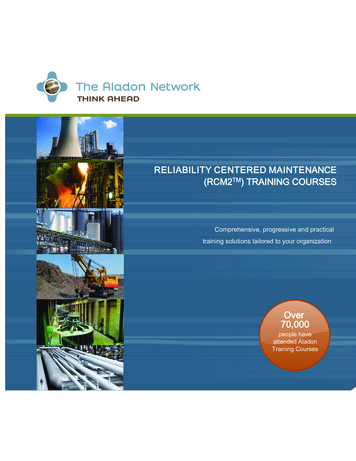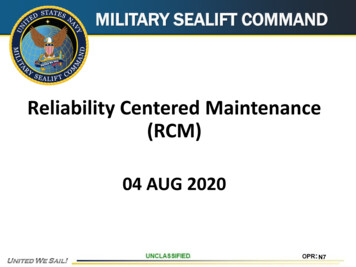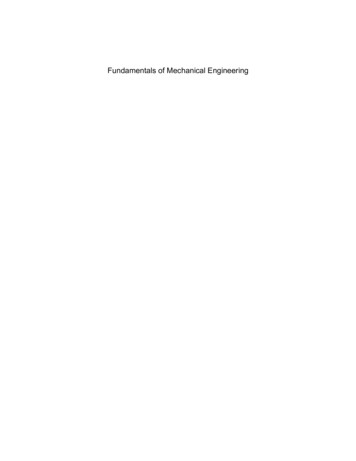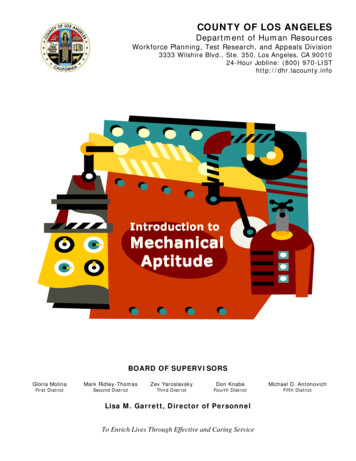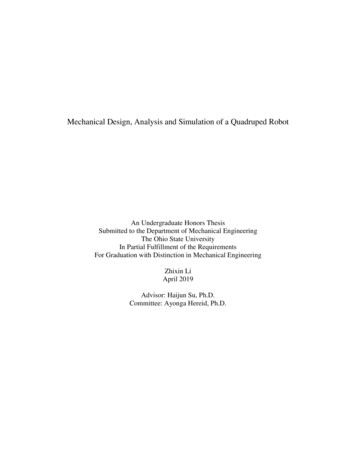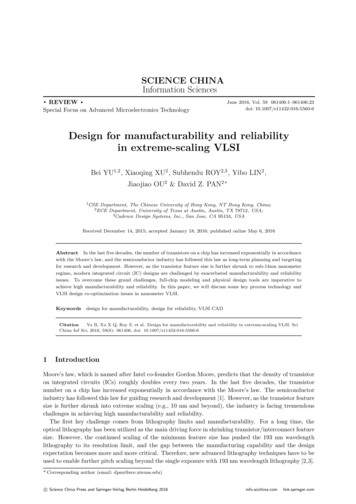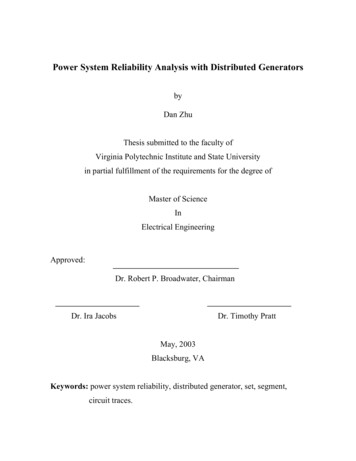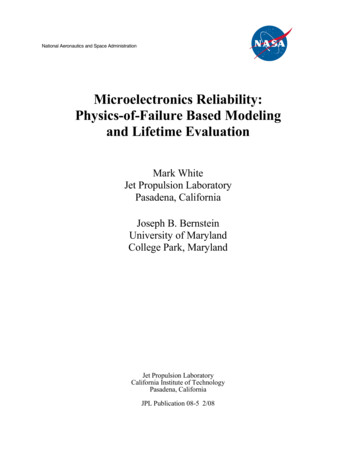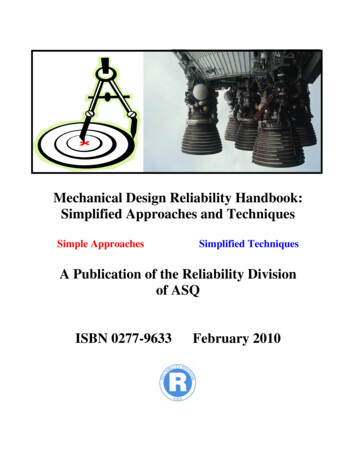
Transcription
Mechanical Design Reliability Handbook:Simplified Approaches and TechniquesSimple ApproachesSimplified TechniquesA Publication of the Reliability Divisionof ASQISBN 0277-9633February 2010
About the AuthorJames McLinn is a reliability consultant with Rel-Tech Group and an activemember of the Reliability Division of ASQ. He holds a CRE, CQE andCMQ/OE from ASQ and has served on the ASQ certification board. He hasproduced three Monographs, Mechanical Reliability, Accelerated Lifetesting and Weibull Analysis. All are available from the Reliability Division.Jim presents short courses and training on a variety of topics of reliabilitywhich range from Design for Reliability to Preparation for the CRE.Reliability Division of ASQThe Reliability Division of ASQ publishes Seven Monographs on ReliabilityTopics. These include Design for Reliability by Bill Tian, PhD; DevelopReliable Software by Norm Schneiderwind PhD and Sam Keene PhD;Homeland Security and Reliability – Airport Model by Norm SchneiderwindPhD; and Credible Reliability Prediction by Laurence L. George PhD.
Mechanical Design Reliability Handbook:Simplified Approaches and Techniquesby James A. McLinn, CRE, Fellow, ASQ10644 Ginseng Lane Hanover, Minnesota 55341Mechanical reliability is one of the sparsely covered areas of reliability. Fewcomprehensive books exist. Most do not cover the full range of subjects that do exist.Additional references are made to help the reader.Basic Mechanical Engineering - This includes how to set up and organize basicmechanical engineering. The simple concepts of stress, strain, tension, shear and fatigueare introduced. Extensive equations and complex situations are avoided in favor ofsimplicity. The stress-load approach is the basis of many of the examples.Time Dependence - Most examples in reliability are based upon static models wherecumulative fatigue is often ignored. Several approaches are shown that permit theinclusion of time into simple models and so show how to model degradation, fatigue orother similar dynamic situations. Coffin-Manson, cyclic stresses and other models arepresented.Accelerated Life - Mechanical reliability situations often involve difficult or hard toaccelerate materials or systems. This short book shows some of the problems andsolutions for these situations.Non-Normal Distributions - Many situations arise where one or more of the strength orload distributions are non-normal. Weibull, lognormal, extreme value are all possibilities.This often changes the analysis and results.Miner's Rule - This basic model is presented as well as limits. This simple model is oneof the approaches for covering a dynamic spectrum of stresses.Confidence Limits - Learn several simple approaches for establishing confidence limitson reliability data.Costs - A short addendum on costs related to projects is included in this book. Thiscritical topic is often left out in most books.Reliability Prediction - An extensive example of how to make a prediction is shown.This includes bottom up approaches and the use of standard books.Copyright Advisory – Copyright is held by the Reliability Division of ASQ. Abstracting ispermitted with credit to source. No reprint or circulation is allowed without specific permission.Contact Monograph editor. Second Edition February, 2010i
Preface - Second EditionUpdated and ImprovedThis first edition of this monograph created a lot of interest in mechanical reliabilitytopics. While the world is primarily electronic, all of the packages, circuit boards, enclosures,housing are mechanical. These primarily serve to protect and support the electronics within. Assemiconductor die shrink and simultaneously increase in power, operate at Gigahertz frequenciesthe packaging becomes a bigger and bigger issue. Heat conduction, cooling, high frequencytermination, compatibility with lead free solder, and ability to remain firmly attached to circuitboards is an increasing challenge. Since the original monograph in 1998, MEMS technology anda host of small scale devices have made an understanding of mechanical reliability moreimportant. Every quality engineer, manufacturing engineer, reliability engineer and projectmanager should be familiar with more of these topics, if only at a basic level. Material properties,magneto-striction, thin films, seals, corrosion, wear out, implantable devices and sensorscombined with quantum effects will dominate the next 10 years of reliability.This monograph will remain short, simple and to the point for all of its examples. Thismakes it easy to follow for quality and reliability engineers. No prior extensive mechanical orreliability knowledge is assumed. The use of statistics remains at a minimum and the backgroundformulas shown where it would be useful to the reader. A wide variety of simple and usefulexamples are shown in the text. The author has presented a much longer reference list and anumber of web sources for those topics that might be of interest to the practical reliabilityengineer. Excessive use of statistical tools has been avoided because most engineers find thelanguage of statistics to be foreign and often obscures the engineering. There are plenty ofstatistics books on the market, if that is the desire of the reader.The first edition contained the following promise. It is still true of the second edition.This short monograph is in no way complete. So many more topics do exist that couldbe covered in greater detail. Some of these topics will be presented in a future edition.James McLinn CRE, Fellow ASQHanover, MinnesotaFebruary 2010ii
Preface - First EditionThis monograph was initially created out of response for the desire for a simple,introductory group of mechanical reliability topics. It began as a series of five articles inReliability Review. When begun there were only two available texts. Both were primarilytheoretical and written for a one quarter college course. This monograph will be found to beshort, simple and to the point for most reliability and quality engineers. No prior extensivemechanical or reliability knowledge is assumed. The use of statistics is kept to a minimum andthe background formulas shown where it would be useful to the reader. A wide variety of simpleand useful examples are shown in the text. The author has presented a much longer reading listand a number of other sources for those topics that might be of interest to the practical reliabilityengineer. Excessive use of or dependence on statistical tools has been avoided because mostengineers find the language of statistics to be foreign and often obscures the engineering orbusiness point being studied. Enjoy this, show it to your co-workers and when you are readymove beyond it to the bigger books and texts that provide many more details. A reading list existsat the end for additional related topics. These are primarily from recent journals.The author also wishes to thank the many people who reviewed this work in its variousiterations and provided helpful comments. Many called to ask about the series, commented aboutthe examples and provided insight to improving them.This short monograph is in no way complete. So many more topics do exist that could becovered in greater detail. Some of these will be presented in a future edition.James McLinnHanover, MinnesotaJune 1998iii
Table of ContentsArea and TopicPage NumberSection 1.0 Simple Approaches to Common Design ProblemsSection 1.1 General Groupings of Reliability ProblemsSection 1.2 Reliability DefinitionsSection 1.3 Types of Applied LoadsSection 1.4 Basic Mechanical EngineeringExample 1.1 Truncated ConeExample 1.2 The Bronze BushingExample 1.3 Different Diameter ColumnsSection 1.5 Shear StressExample 1.4 The Yield AngleExample 1.5 Stress in a SpringExample 1.6 The Active SpringExample 1.7 Spring Force ConstantExample 1.8 Spring Steel WireSection 1.6 Structural ExamplesExample 1.9 A Beam with Two StressesSection 1.7 Single Force on a BeamExample 1.10 Beam DeflectionExample 1.11 A Uniform LoadSection 1.8 A Reliability Model, Stress LoadSection 2.0 Dynamic ExamplesSection 2.1 A Stepper MotorExample 2.1 Repetitive Cyclic StressesExample 2.2 Minimum Driving ForceSection 2.2 Simple Time DependenceExample 2.3 Dynamic Time DependenceExample 2.4 More Dynamic ReliabilitySection 2.3 Calculating Minimum Zero Time ForceExample 2.5 Slow DegradationExample 2.6 Alternative Slow DegradationSection 2.4 The Importance of DegradationSection 3.0 Dynamic DegradationExample 3.1 Dynamic Degradation in Reliability ModelsExample 3.2 Alternate Standard DeviationSection 3.1 Cyclic Stress and FatigueExample 3.3 Miner's Rule and Accumulated FatigueExample 3.4 A Simple Application of Miner’s RuleExample 3.5 The S-N curveSection 3.2 Reduction of Random StressesSection 3.3 Confidence limits on S-NExample 3.6 Confidence Limits CalculationsSection 3.4 Interference when Distributions are Non-NormalExample 3.7 Interference of a Normal and Weibull DistributionExample 3.8 Approximation by Equivalent DistributionsExample 3.9 An Improved 5252626272727292929303131323232333537393940404243
Section 4.0 Mechanical Reliability PredictionSection 4.1 Background of PredictionsExample 4.1 A Motor Reliability ModelExample 4.2 Consideration of WearExample 4.3 Dynamic Hazard Rate CurveSection 4.2 The Carderock Models of Mechanical ReliabilityExample 4.3 A Coil SpringExample 4.4 Hard Drawn Steel SpringExample 4.5 A Roller BearingExample 4.6 Ball BearingExample 4.7 Reliability Calculations from First PrinciplesExample 4.8 Minimum Applied StressExample 4.9 Simple Reliability ModelExample 4.10 Total Mechanical SystemExample 4.11 A Non-Constant ModelSection 5.0 Confidence Intervals in Mechanical ReliabilitySection 5.1 Calculating ConfidenceExample 5.1 Confidence on the Deflection of a BeamExample 5.2 Tchebyshev's Approach to UncertaintyExample 5.3 Gauss' InequalityExample 5.4 Cam-Meidell ApproachExample 5.5 Trivial Confidence BoundsExample 5.6 Improved Cut Set Confidence BoundsExample 5.7 More Complex Confidence BoundsExample 5.8 The F Distribution for ConfidenceExample 5.9 Traditional Chi-Square DistributionSection 5.2 Accelerated Testing ExamplesExample 5.10 Simple Acceleration of a Mechanical SystemExample 5.11 Alternate Accelerations and Wear RatesSection 5.3 Mechanical Materials AccelerationSection 5.3.1 Mechanical Models that Describe ReliabilitySection 5.3.2 Stress-Life RelationshipsSection 5.3.3 Arrhenius, Power Law or EyringSection 5.4 Discrete Mechanical SystemsExample 5.12 A Weakest Link in a Discrete Parallel SystemExample 5.13 Estimating Confidence Limits for a Discrete 4656667697071717272737475767679Bibliography and References80Appendix Cost and Project Issues81v
Table of FiguresDescription of the figurePage NumberFigure 1.1 The Stress-Strain CurveFigure 1.2 The Truncated coneFigure 1.3 Stress in a Cone and ColumnFigure 1.4 A Combination ShaftFigure 1.5 The Tapered ShaftFigure 1.6 Shear Forces in MaterialFigure 1.7 External Twist on a ColumnFigure 1.8 The Helical SpringFigure 1.9 Stress Distribution in a BeamFigure 1.10 Free End of a BeamFigure 1.11 A Uniform LoadFigure 1.12 The Stress-Load modelFigure 2.1 The Simple Stepper MotorFigure 2.2 Simple Time Dependence of ReliabilityFigure 3.1 A Stress-Load Degradation ModelFigure 3.2 A Summary of Stresses in a Three Day PeriodFigure 3.3 Crack Propagation in a Large PlaneFigure 3.4 The S-N curveFigure 3.5 Summary of Irregular LoadsFigure 3.6 Simple Time Listing of StressesFigure 3.7 Confidence Limits on the S-N curveFigure 3.8 Cyclic Stresses in an Aluminum BarFigure 3.9 Interference of a Normal and Weibull DistributionFigure 3.10 An Equivalent Normal DistributionFigure 3.11 An Improved Normal DistributionFigure 4.1 A Mechanical Bathtub modelFigure 4.2 Spliced Early Portion of the BathtubFigure 4.3 Dynamic Hazard Rate CurveFigure 4.4 Aluminum Faucet AdaptorFigure 4.5 Actuator ExampleFigure 4.6 Water System Failure Rate CurveFigure 5.1 Deflection of a Wide Beam under LoadFigure 5.2 – The Probability Plot of a Position IndicatorFigure 5.3 Gauss’ InequalityFigure 5.4 Camp-Meidell ModelFigure 5.5 A Simple SystemFigure 5.6 Cut Sets and Tie SetsFigure 5.7 A Complex SystemFigures 5.8A and 5.8B Decomposition of a Complex SystemFigure 5.9 Slow Wear of the Mechanical BathtubFigure 5.10 Dual Stress-Life RelationshipFigure 5.11 Discrete Stress-Load ExampleFigure 5.12 Distribution of 7384041414344464748525457596263646667686873747778
AppendixFigure A1 The Eight Dynamics of a Development ProjectFigure A2 The Development Failure Breakdown Observed on System AFigure A3 The Development Failure Breakdown Observed on System BFigure A4 First Year Field Data from System AFigure A5 First Year Field Data from System BFigure A6 Second Year Field Data from System AFigure A7 Performance of Successive Lots85868688888990List of TablesTable NumberTable 1.1Table 1.2Table 1.3Table 3.1Table 3.2Table 3.3Table 4.1Table 4.2Table 5.1TopicPageModern Mechanical Reliability ApplicationsTop Twelve list of Mechanical Reliability ProblemsBasic Properties of Common MaterialsA Summary of High StressesSummary of Irregular LoadsCharacteristics of a Round BarData for Bathtub CurveSummary of Component Failure Rate InformationSummary of Discrete Stress and Load268343741485678List of Typical Levels of FailureU.L. Definitions of Critical ComponentsTypical Costs associated with System A838391AppendixTable A1Table A2Table A3Appendix References92vii
Mechanical Design - Reliability Primer1.0 Simple Approaches to Common Problems of Design, Manufacture and FieldSituationsModern reliability tools and techniques have developed primarily 30 to 50 years ago.Reliability books in the last 30 years have been primarily devoted to the evolving electronicindustry. This situation is highly ironic for mechanical reliability applications have been aroundover 5000 years. This ancient knowledge formed the basis for much of the well recognizedmodern electronic applications. The oldest reliability references can be found on ancientSumerian clay tablets from about 2500 BC [1]. They stated that houses were to meet minimumstructural standards and could not fall down upon the occupants under penalty of death of thebuilder. This millennium (3000 to 2000 BC) seemed to be part of a world wide building boom.Stonehenge, many pyramids and a variety of smaller structures sprang up all over the world.These structures seem to represent attempts to create lasting monuments. This wasn't done in avacuum. The larger pyramids such as at Giza have smaller and older, practice pyramids nearby.The Egyptians slowly learned the basic engineering principles and then expanded them overhundreds of years. The Romans also had a desire to build lasting structures. They expanded theolder Mesopotamian knowledge of water movement by expanding and improving aqueducts andarch bridges. The Romans are best known for lasting roads, many buildings, the Coliseum and avariety of structures during their Pax Romana. Many of these now ancient structures still exist inworking order. Other cultures also shared in the lust to build lasting structures in stone. Theseinclude Stonehenge in England, the Parthenon in Athens and the massive stone temples and citiesof the Inca world.All of the structural (mechanical reliability) principles in use from the ancient times werebased upon slowly gained knowledge of materials, geometry, structures and included anticipatedaging of these structures. The plane, fulcrum, Archimedes screw, early concepts of tension versusshear all were in use. Simple mathematical models probably existed for some of the structures,but it is not clear how detailed these models might have been. What exactly does this have to dowith modern mechanical reliability? Many of the modern mechanical reliability applications thatcover materials and common structures are very similar to the knowledge gained from the past.Today, plastics, steels and aluminum have replaced wood, stone, copper and iron, but theapplication principals have changed very little. We benefit today by the wealth of reliabilitymodels and the development of advanced mathematics that describe complex situations. Thesepermit descriptions of a variety of different potential applications. A short review of history hasshown that these principles were preserved and came to fruition again at the end of the dark ageswith the building of large churches, castles and cities. These set the stage for more modernstructures. Eventually schools of architecture were founded and the subject taught in theuniversity by the late 1600s. Christopher Wren was perhaps the most famous architect of thattime. He built a number of famous structures and rebuilt older ones. Some of these olderstructures, such as the 400 foot cathedral spire at Salisbury England had begun sagging after only300 years. His solution was simple, encase the four support columns with strategically placedmetal bands. The necessary knowledge of tension, shear and torque were all required for thissimple solution implemented in the 1670s. Many other people of the past have contributed to theknowledge we employ today. These include mathematicians such as Poisson, Gauss, Cardan, DeMoive, Abbe and von Neumann. Additionally, people such as Newton, Hooke and Weibull havecontributed material studies. The approaches of the recent past are very similar to those faced bymodern mechanical engineers and reliability people. The main difference is the availability ofmore complex models and the ready use of modern computers.1
The following table is a short (modern) summation of some basic important approachesemployed in many common modern situations. These are grouped by basic approach and are tiedto specific applications of specific reliability tools and approaches. Later, sections of this bookwill provide specific examples tying tools, applications and simple statistical models that enhancereliability estimation. Basic engineering principles and models are also shown. This book willcover only some of these approaches. Simple principles can go a long way to providingreasonably accurate answers in most situations.Table 1.1 - Modern Mechanical Reliability ApplicationsStatic Applications with Constant Stress- Tension, Shear, Torsion, andDegradation corrosion involved StructuresDynamic Applications & StressesVariable, Full Reversing or Irregularstresses in place Materials Structures Historically Based SituationsThe following list of more specific mechanical reliability applications can be placed under one ormore of these broad categories above.1. Stress-Load analysis (interference) both static and dynamic situations.2. Modeling with distributions covering common and infrequent events.3. Probability estimates - Tchebycheff's, Gauss's or Camp-Meidell methods covering nonparametric and non-symmetrical probability distribution situations.4. First principle modeling and physics of failure (PoF) approaches.5. Coefficient of variation.6. Part or function table information - a list of common failure modes and causes.7. Dynamic multiple cyclic loads with Miner's Rule.8. Full reversing load situations.9. Dynamic variable and irregular loads with reduction to equivalent cyclic stress.10. Monte Carlo simulation or other simulation methods.11. System reliability modeling.12. Finite Element Analysis - FEA.13. Failure Mode and Effects Analysis - FMEA.14. Hazard Analysis – HA or Health and Hazard Analysis - HHA.15. Fault Tree Analysis - FTA.16. Approaches employing the concept of entropy or system disorder.17. Materials limits and material fatigue concepts.18. Possibility of chemical attack, chemical degradation, galvanic action or "stiction".2
1.1 General Grouping of Mechanical Reliability ProblemsApproaches to Mechanical Reliability take a number of different avenues. This is becausethere are so many different mechanical functions possible. These include a variety of structuralproblems from the construction of buildings, bridges and damns to simple metal chassis as usedto protect electronics. In more common mechanical reliability analyses we look at the stiffnessand strength of materials such as ceramics, fiberglass, iron and steel. Our analysis also considersthe lubrication of metal surfaces. The variety of applications of mechanical functions can begrouped into similar approaches. Some approaches may be grouped as follows. This list expandssome of the entries in Table I.1. The types of mechanical functions required. These may vary from static to dynamicsituations. These dynamic may be broken down into several different dynamic applications.2. The range of stress of the mechanical part, material or system. We need to identify ifthe stresses are close to the ultimate tensile strength or any other "plastic limits" of the material. Ifbelow the plastic limit, we might often model these with simple elastic models.3. Material fatigue may be an important issue to consider when accumulative fatigue ordegradation begins to become important. Fracture mechanics are important in some high stress orhigh reliability applications.4. Situations where the stresses are continuous in time or strength, cyclic in time orstrength or semi-periodic or irregular in time or strength. Continuous forces, shear forces orpressures are more easily handled than cyclic, periodic or reversing forces. The hardest situationsare irregular or unpredictable forces. In many situations we can lump forces into "equivalentgroups" or reduce forces to their equivalents.5. Variability of the forces. Can a stable mean force (or result) be identified? Is thevariation about the mean value also stable over time or samples? Can the variation be describedor approximated by the Normal distribution, LogNormal or Weibull. In these situations we havestatistical results, not straight forward cause and effect results.6. Identify the potential failure modes of a component, material, function or system andultimately the root causes of failures. Knowing these can be much more important formechanical situations than for electronic parts and systems. Knowledge of the causes usuallyleads directly to knowledge of improvements and preventative actions.7. The Failure Mode Effects Analysis may be a good approach for looking at potentialcauses of system failures because there are often a small number of failure modes for manymechanical systems, functions, materials or parts. Many of these failure modes are tiedclosely to the way a part, material, function or system is employed ( application) or to thematerial and/or geometry present.8. Possibility of chemical attack, galvanic action, "stiction", dendritic growth, corrosion,oxidation and a variety of degradation modes exist. Each of these need to be considered as a rootcause of an eventual mechanical failure.9. "Reduction to first principles" is a common mechanical approach. This approach isanother way of writing down what you know, use basic engineering or physics principlesand write a simple equation.3
10. Application of common accelerated life test methods for mechanical parts, materials,functions and systems. The problem is that many of the stress factors are either very low or veryhigh. In either case it is often very difficult to identify and set up a good reasonably shortaccelerated life test. Consideration of multiple overstress tests or step-stress approaches will beprovided.1.2 Mechanical Reliability DefinitionsTypically this area breaks into two types of reliability problems.* Mechanical parts - such as switches, relays, bearings etc. that are wear out dependent. This is anapplication of many repetitive actions with minor wear at each cycle. We typically estimate life orrun tests to ensure reliability of a distribution.* Structural situations - Often thought of as a civil engineering situation. A material with a basicstrength is expected to withstand the accumulation of stresses over time. Analysis of thesesituations works for housings, enclosures, buildings, bridges, dams etc. Some reliability problemsfor parts or systems may also fall into this category.Definitions needed for Mechanical ReliabilityMaterial - A collection of defects.Acceptable Material - A fortuitous or organized collection of defects in a material. The materialis characterized by having a long time to failure.Unacceptable Material - An unfortunate and disorganized collection of defects. The material ischaracterized by have a short time to failure.A variety of recurrent mechanical problems are listed in Table 1.2. These are based uponexperiences over 25 years. Not all mechanical applications have the same requirements, so itwould not be surprising if a biomedical application had a different requirement than a consumerone.Table 1.2 - Top Twelve list of Mechanical Reliability Problems1. Always assume the worst will eventually happen. This applies especially to criticalparts and assemblies. Know what is critical especially to the use and customers. What are thecritical parts? How will the customer abuse the assembly?2. Always check for tolerance stack up problems. Parts in tolerance today may not be inthe future. Don't assume stability from the suppliers or that wear can not occur. Most of the timewe do not know the relationship between being in specification and the ultimate reliability. ADOE (Design of Experiments) would help here.3. Metal inserts in plastic parts are hard to mold well. This may lead to problems in usebecause of residual stress and will eventually cause problems through tool wear and/or partcracking.4
4. Always maximize the radii that are present. Small radii lead to high stressconcentrations and failure prone places. Harden these areas or use harder metals where possiblewhen the radii can not be increased.5. Use as few connections as possible. This includes connectors, wire connections such aswelds or solder joints, crimps and material connections and seals. Remember all connections arepotentially weak points that will fail given time and stress.6. All seals fail given time and stress. You need at least two levels of sealing to ensure theproduct will last as long as the customer expects. Remember that some materials diffuse throughothers. Perhaps three levels of seal are required.7. Threads on bolts and screws shouldn't carry shear loads. Remember they need preloadsand/or stretches to ensure proper loading initially. Metal stretches, fractures and corrodes as wellas developing high stress concentrations in use under tension. Be sure to allow for this.8. Use as few nuts, bolts and screws as possible. While these are convenient temporaryconnection methods, it is 100 year old technology. Lock washers and locktite have beendeveloped to slow down the rate of loosening. All will eventually come loose anyway when thereis stress, temperature or vibration present.9. Belts and chains will stretch and/or slip when use to deliver power. Remember thesetypes of parts need constant tension devices to aid their reliability. Again this is old technologythat can be made reliable by careful application. (Note, this is one of the biggest field problemwith snow-throwers.)10. Avoid set screws as these easily come loose because of their small sizes. Even whenused on a flat, set screws are only "temporary connection" mechanisms. Locktite only makes "thetemporary" a little longer in the presence of stress.11. Watch the use of metal arms to carry loads. They often deflect in an imperceptiblemanner. This is especially true when loads are dynamic.12. Integrate as many mechanical functions as possible. Use as few separate and distinctmechanical parts that are joined as possible. Joints are usually unreliable.Each of these common mechanical design problems is used in common "every day life"situations where 10% failures per year might be acceptable or near the limit of technology(washing machines, other appliances, many instruments and even some cars). The same standarddesigns will not work well in high reliability applications where only 1 or 2% failures per year aredesired or acceptable (aerospace, military, medical devices etc.). Remember the differencebetween the two applications when designing.1.3 - Types of Applied Loads, Stresses and Material ResponseAlmost all situations of mechanical engineering may be reduced to four basic classes ofapplied loads. The applied loads may in turn be described through internal stresses or evenmaterial strain. These stresses may be simply described as:5
1) Compression2) Tension3) Shear4) TorsionAll other internal stresses may be made up of combinations of these stresses be they static ordynamic situations. The material reliability may be measured through strength or durabilityconcepts that include the following:1) The capacity to withstand a static load over a specified time and stated environmentalconditions.2) The resistance to permanent internal or external deformation or damage resultant fromby a one-time high load.3) The toughness of a material under a shock load or an impact type test.4) The measure of the life of a material when subjected to cyclic loads or fatigue.5) The material behavior exhibited at high or low temperature, including crackingcreep or induced internal stress.As a rule, the applied loads are typically thought to be reflected as simple tension or compression.This not need be so. The loads may lead to shear or torsion stresses in addition to tension orcompression. In the latter cases the details become more complex, but the basic approach remainsthe same. The model of the material response may vary as do the applied loads. The followingdescription, as well as Figures 1.1a and Figure 1.1b, provides a generic, first-order relationshipfor a variety of materials.In tension or compression testing, typically two distinct phases or different materialresponses may be identif
Mechanical Design Reliability Handbook: Simplified Approaches and Techniques . Simple Approaches Simplified Techniques . A Publication of the Reliability Division of ASQ . ISBN 0277-9633 February 2010 . About the Author . James McLinn is a reliability consultant with Rel-Tech Group and
